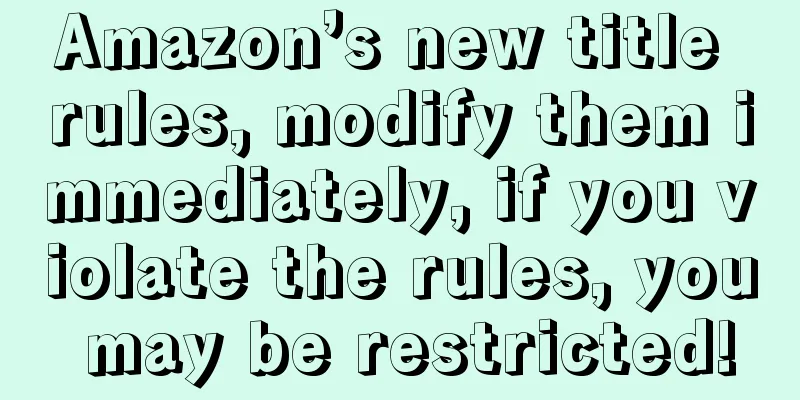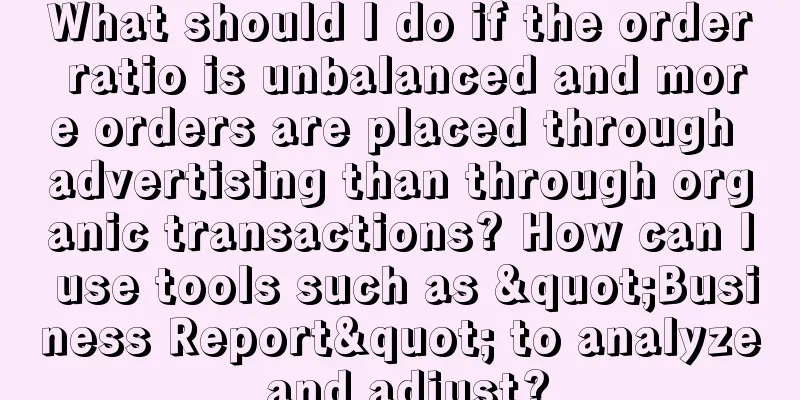Amazon’s new title rules, modify them immediately, if you violate the rules, you may be restricted!

|
Recently, Amazon has made a new move! This time the "change" is directly directed to the product title. Sellers must adjust as soon as possible to avoid touching the platform's red line! If the title does not comply with the new regulations, it will at best affect traffic and conversions, and at worst the product may be directly removed from the shelves, with quite serious consequences. In order to prevent everyone from being caught off guard, Zhaodanmao Cross-border has sorted out the key points of the new regulations as soon as possible and teaches you how to respond quickly! Key changes in Amazon’s new title rules
1. Reduce the length of the titleAmazon has reduced the character limit for titles from 250 to 200 characters (including spaces). This means that sellers need to accurately convey product information in a shorter space, making it concise and focused . The era of randomly "stacked" keywords is over. 2. Disable special charactersThe new rules explicitly prohibit the use of special symbols in titles, such as exclamation points (!), dollar signs ($), question marks (?), underscores (_), vertical bars (|) , etc., unless these symbols are part of the brand name. This regulation is not only intended to enhance buyers' shopping experience, but also to optimize search algorithms and reduce search result bias caused by character interference. 3. Avoid repeating keywordsThe same keywords cannot be repeatedly used in the title, except for prepositions, articles and conjunctions . This regulation further requires sellers to avoid the old routine of "keyword stacking" when optimizing titles, and instead pursue clear and concise expressions to present a professional and friendly title to buyers.
1. Optimize existing titlesFirst, take out your list of product titles and review them one by one against the new regulations: Is the character length exceeded? Are there any illegal symbols? Is there a keyword duplication problem? It is recommended to use Amazon backend tools or third-party data analysis software to check the click-through rate and conversion rate of the title , find the weak points in the title, and make targeted optimizations. The new regulations are a challenge, but they are also an opportunity to optimize the title and improve competitiveness. 2. In-depth keyword researchThe title is shorter, so the choice of keywords must be more precise! You need to study the search habits and popular keywords of the target market , and combine them with long-tail keywords to find the words that can most accurately attract buyers. In addition, you might as well pay more attention to your competitors’ title optimization strategies: What keywords do they use in their titles? Are there opportunities for differentiation that can be seized? Only by choosing the right keywords can your title create higher value within limited characters! 3. Enhance product details pageThe title length is limited, and many sellers are concerned: "What if there is not enough information and the product advantages cannot be written?" The answer is: If the title can’t explain it all, add more on the details page! Combine pictures, videos and text to fully display the functions and selling points of the product; Write important information into the five-point description to strengthen the buyer's understanding of the product; Make sure the page is clean and concise to reduce buyer doubts and bounce rates. New regulations remind you: The consequences of violations are serious!At the very least, traffic will be restricted , resulting in decreased product exposure and sales; In serious cases, the product will be directly removed from the shelves or even the account funds will be frozen. In addition, the new regulations have put forward higher requirements for buyer experience, which also shows that Amazon is paying more and more attention to the standardized operation of the platform, and the rules will only become stricter in the future. If sellers want to stand out from the competition, they must play by the rules . Summarize Amazon’s new title policy has been fully implemented. For sellers, although it takes time and effort to adjust in the short term, in the long run, this is also an opportunity to optimize titles and improve competitiveness. After the title is simplified, it is easier for buyers to understand the product advantages and search matching is more accurate, which is undoubtedly a good thing for improving conversion rates! Adjust your title, start now! Don't wait until you violate the rules to regret it. I hope this analysis can help you respond to changes quickly. If you find it useful, remember to share it with other seller friends! 👍 Today's Share Amazon sellers must learn how to prevent and avoid copycat sales |
<<: Amazon bans account again! More than 5,000 accounts hit
>>: Amazon Vine plan has a major update in 2025, and sellers will lose if they miss it!
Recommend
What is RMA (Return Material Authorization)? RMA (Return Material Authorization) Review
RMA is the abbreviation of Return Material Authori...
What is Guangzhou Damu Information Technology Co., Ltd.? Guangzhou Damu Information Technology Co., Ltd. Review
Guangzhou Damu Information Technology Co., Ltd. is...
Survey on consumer trends during the US holiday season! These gifts are popular this year...
According to a survey by Oracle Retail, 36% of Ame...
What is worth buying? What is worth buying review
The website "What's Worth Buying" wa...
U.S. retail spending in July exceeded expectations as consumers spent heavily on Prime Day
It is learned that according to foreign media repo...
Amazon forces discount mechanism to be enabled? Sellers lose costs and orders!
A MZ123 has learned that the Regional Comprehensiv...
The listing was removed from the shelves for no reason, and my brother-in-law started taking action again!
Trump's black humor makes people speechless. T...
What is Dingmai Academy? Dingmai Academy Review
Dingmai Academy is a cross-border e-commerce skill...
What is Zoho Commerce? Zoho Commerce Review
Zoho Commerce is a true omnichannel solution. It f...
This year there is no golden March and silver April, but it feels more like an off-season
Recently, many Amazon sellers have stated that the...
The new tariff policy has set off a chain reaction, and the cross-border industry has suffered a critical blow!
It is learned that at 00:01 on February 4, 2025, E...
What is Ticket Monster (TMon)? Ticket Monster (TMon) Review
Ticket Monster (TMon for short) is the largest gro...
What is EMC? EMC Evaluation
The full name of EMC (Electromagnetic Compatibilit...
The “halo effect” of back-to-school shopping: U.S. e-commerce app downloads surge
According to the latest data released by mobile an...
As internal circulation prevails, profits fall below the red line, and sellers call for an end to philanthropist behavior!
It is understood that according to foreign media r...









